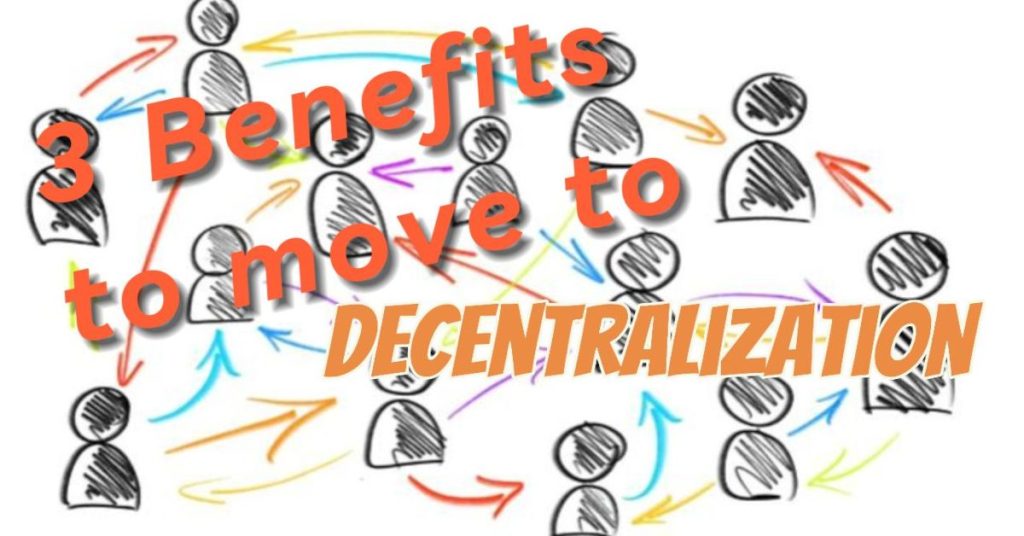Page Contents :
The Definition Of Decentralization
Fundamentally speaking, decentralization is to transfer the power and authority of a central institution or community to its members and making the community members self-sovereign.
Power is that the force to regulate others forcibly within the system, and authority is that the right to exert this influence.
The Move To Decentralization
First, let’s start by understanding the structure of the Internet. In fact, the Internet world is monopolized by a few Internet service providers and only provides a single Internet media service. Our data is stored in its intranet database, and therefore the Internet is constructed around these centralized institutions.
We must pay fees to those intermediaries to use their services and products like Facebook, Amazon, Google, or various retail bank accounts, etc. However, these intermediaries will collect our information, browsing habits, purchase records, and other data through those free online services, and sell our personal data for profit, with or without our knowledge.
Having said that, why can others benefit from our personal data?

Now we are on the point of entering an era of self-sovereignty that’s not constrained by centralized intermediary custody. Power is going to be transferred from centralized intermediaries to users, they’re going to have that self-sovereignty to manage their digital assets and personas.
Three Main Forms Of Decentralization
BitTorrent could be an example of decentralization. It’s a point-to-point file-sharing protocol that uses a distributed architecture system and doesn’t rely on any single server company or entity to supply users with file sharing.
To some extent, Bitcoin is similar to BitTorrent. It can send cryptocurrency to two people that want to exchange currency without going through any intermediary or bank. This transaction model enables them to complete peer-to-peer transactions autonomously within the blockchain.
Vitalik Buterin, the founder of Ethereum, detailed the three forms of decentralization:
- Architectural (de)centralization: How many nodes does this system consist of? At the same time, how many nodes can the system tolerate failures without being affected?
Let’s get specific, if a system only exists in 3 computers, though there are strict protection measures, as long as these 3 computers are destroyed at the same time, then the system will naturally be destroyed. Take the Bitcoin system as an example, there are thousands of nodes distributed all over the world, and it’s impossible to destroy it whether it’s a cyber-attack or physical destruction. So at the architectural layer, the wider the distribution range, the more connected nodes, the more decentralized.
- Political (de)centralization: How many individuals or organizations jointly control the ultimate control of the computers that make up this system?
Taking Bitcoin as an example, its nodes belong to many different institutions and individuals. If you want to attack Bitcoin, then you need to aggregate over 50% of the computing power, which is impossible for organizations or individuals. So at the political layer, the more ultimate controllers of the computers that make up the system, the more decentralized it is.
- Logical (de)centralization: From the system’s interface and data structure, is the system a whole or a cluster composed of countless units? A simple heuristic: If the system is divided into two halves, and both contain the providers and users, can these two independent units still operate intact?
Whether it’s singularity or clustering, the former is logically centralized, and the latter is logically decentralized. Take the Bitcoin system as an example. Once the system is divided into two, its overall consensus is going to be destroyed and therefore the system will no longer exist.
The blockchain doesn’t have a unified server, so there’s no infrastructural central point of failure – architecturally decentralized. Meanwhile, no individual or organization can completely control it – politically decentralized. But blockchain has to reach a common consensus and behaves like a single computer – logically centralized. Although the blockchain is centralized within the logical layer, it’s decentralized in the other two layers, therefore the blockchain is also decentralized.
Three Reasons Why Decentralization Is Beneficial
Vitalik also mentioned that why decentralization is beneficial to the blockchain at the political and architectural levels:
1. Good fault tolerance: Since the decentralized system relies on separate nodes, the decentralized system is unlikely to cause the whole system to fail because of the failure of some nodes.
Fault tolerance is often explained by simple mathematical probability: the probability of a computer failure is clearly greater than the probability of a failure of 100 computers at the same time. For instance, putting 10 eggs in one basket and putting them in multiple baskets, which one is easier to break? So decentralization is also the way to diversify risks.
2. Strong resistance to attack: Since the decentralized system lacks a sensitive central point and is spread across many nodes, the cost of attacking, destroying, or manipulating the decentralized system becomes higher.
In general, the cases of attack and defense are asymmetrical in favor of the attacker. However, the leverage effect of an attack is usually sub-linear. For example, if you would like to destroy a building that costs $10 million, you need to spend $100,000 to destroy (ratios of 1%), and to destroy a building that costs $1 million, perhaps only need $30,000 to destroy (ratios of 3%). Similarly, the lower the cost, the higher the ratios of destroys.
3. Strong resistance to collusion: The leadership of centralized companies and the government has always colluded with each other in a way that is beneficial to them, harming less well-coordinated citizens, customers, employees, and the general public. It is harder for users in a decentralized system to collude and take advantage of the other users.
Blockchain is based on the idea that every node can operate independently. Blockchain users believe that the blockchain is extremely secure because nobody can tamper with the rules of the protocol as they like, but if the development teams of the blockchain software and the protocol are from the same company or within the same location, then the blockchain is not that safe anymore. Therefore, it is difficult for its employees to collude with each other in a decentralized blockchain network, so it is safer.
Decentralization allows us to grasp a part of the blockchain knowledge. In the next lesson, we’ll explore the blockchain ledger.





Very good post. I absolutely appreciate this website. Stick with it!